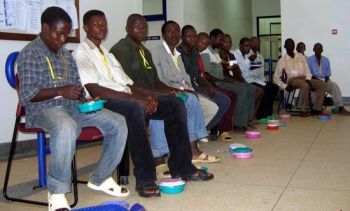
Publisher:
Bonnie King
CONTACT:
Newsroom@Salem-news.com
Advertising:
Adsales@Salem-news.com

~Truth~
~Justice~
~Peace~
TJP
Feb-29-2012 22:10

 TweetFollow @OregonNews
TweetFollow @OregonNews
Impact of Male Circumcision on HIV Doubted
Gilbert Nyambabvu Special to Salem-News.com“Male circumcision is a dangerous distraction and a waste of scarce resources that should be used for known preventive measures (such as condoms which are 80 percent effective.” - Australian Journal of Law and Medicine
 New doubts ... Men waiting to undergo circumcision |
(BIRMINGHAM, WEST MIDLANDS, UK) - MALE circumcision is a dangerous distraction in the fight against HIV/AIDS, researchers have warned insisting that contrary to widespread claims the procedure only reduces transmission rates by no more than 1.3 percent.
Zimbabwe is among several countries in sub-Saharan Africa that have launched mass male circumcision campaigns after the World Health Organisation (WHO) and UNAIDS recommended the procedure in 2007 as an effective HIVAIDS preventive measure.
The WHO/UNAIDS recommendation was based on clinical trials carried out in Kenya, South Africa and Uganda which suggested that circumcision could reduce female-to-male HIV transmission by up to 60 percent.
Thousands of men have undergone the surgical nip and tuck since Zimbabwe launched the campaign in 2009 with promoters enthusiastically claiming that if at least 80 percent of the adult male population was circumcised about 750 000 cases of HIV infections could be prevented. But new research has cast doubt on the supposed efficacy of the procedure with an article in the December Australian Journal of Law and Medicine citing numerous flaws in the Kenya, South Africa and Uganda studies.
Researchers Gregory J. Boyle and Gregory Hill claimed the 60 percent reduction in transmission was only relative with the absolute reduction rate actually no more than 1.3 percent.
 Dangerous distraction ... |
Boyle and Hill said: “What does the frequently claimed ‘60 percent relative reduction’ in HIV infections actually mean?
“Across all the three female-to-male trials, of the 5,411 men subjected to male circumcision, 64 (1.18 percent) became HIV positive while among the 5,497 controls 137 (2.49 percent) became HIV positive. “So the absolute decrease in HIV infection was only 1.31 percent, which is statistically not significant.”
The authors of the article insisted that the WHO/UNAIDS recommendation “uncritically accepted” the findings of the Kenya, South Africa and Uganda trials, in the process ignoring a vast body of contradictory evidence.
“Examination of epidemiological data shows that male circumcision does not provide protection against HIV transmission in several sub-Saharan African countries including Cameroon, Ghana, Lesotho, Malawi, Rwanda and Tanzania all of which have higher prevalence of HIV infection among circumcised men,” they said.
“In Malawi, the HIV prevalence rate is 13.2 percent among circumcised men and 9.5 percent among those who are intact. (Again) in Cameroon prevalence among those circumcised is 5.1 percent compare to 1.5 percent for those who are intact.
“If male circumcision reduces HIV transmission as the trials claim then why is HIV prevalence much higher in the United States (where most men are circumcised) than in developed countries where most men are intact (such as Europe, the United Kingdom and Scandinavia)?”
The article warns that relying on male circumcision in the fight against HIV/AIDS is especially dangerous for sub-Saharan Africa women because circumcised men could still acquire and transmit the virus to their sexual partners.
“Evidence suggests that mass circumcision programs may exacerbate the HIV epidemic among women (and) under these circumstances it would be irresponsible and unethical to advocate mass circumcision programmes in southern Africa,” the article concludes.
“Male circumcision is a dangerous distraction and a waste of scarce resources that should be used for known preventive measures (such as condoms which are 80 percent effective.”
Originally published by New Zimbabwe
Articles for February 28, 2012 | Articles for February 29, 2012 | Articles for March 1, 2012



googlec507860f6901db00.html


Terms of Service | Privacy Policy
All comments and messages are approved by people and self promotional links or unacceptable comments are denied.
[Return to Top]
©2025 Salem-News.com. All opinions expressed in this article are those of the author and do not necessarily reflect those of Salem-News.com.